Equipment
- Appropriate personal protective equipment (PPE)
- Sterile water for inhalation 1000 mL bag
- Appropriate patient interface: High flow nasal cannula (of appropriate size), tracheostomy adapter, or mask
- Wiggle pads (if applicable)
- Duoderm (if applicable)
Suction tubing, appropriate sized Yankeur and Little Sucker™ (a suction catheter)
For set-up of F&P Optiflow stand with 950 humidifier system:
- High efficiency humidification device (Fisher & Paykel Humidifier Model 950)
- Heated breathing circuit kit with autofeed humidification chamber
- < 10 kg : Neonatal Optiflow nasal high flow kit (950N40J) (Flow range : 0.5 - 36 L/min)
- > 10 kg : Adult Optiflow nasal high flow kit (950A40J) (Flow range : 5 - 70 L/min)
- Dual flow inlet adapter (for gas tubing connection to the adult breathing circuit)
- Oxygen tubing
- Oxygen blender
- High pressure air and oxygen hoses
Oxygen flowmeter (attached to the blender)
Image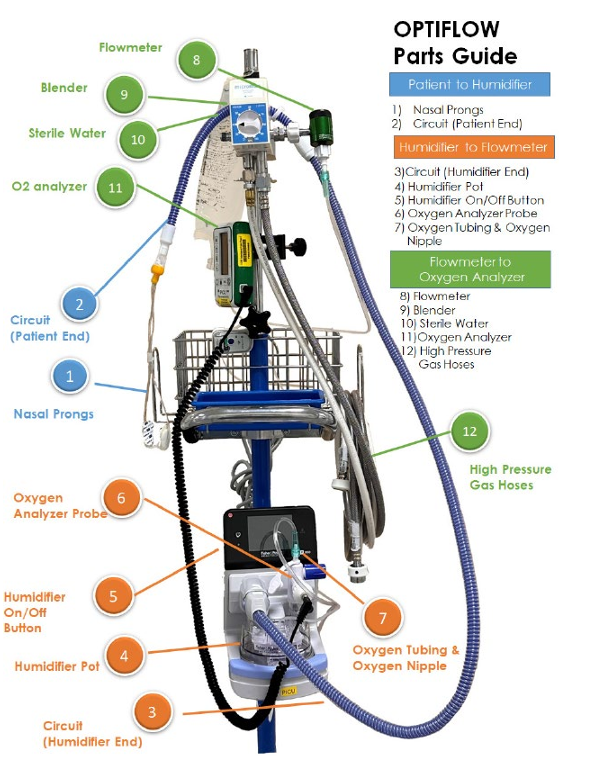
For set-up of F&P Airvo 2 system:
- Fisher & Paykel Healthcare Airvo™ 2 Humidification System (Airvo™ 2) +/- external battery
- Airvo™ 2 heated breathng tube and chamber kit
- Oxygen tubing
- Disinfection tubing, upon discontinuation
Oxygen flowmeter (attached to the wall oxygen outlet)
Image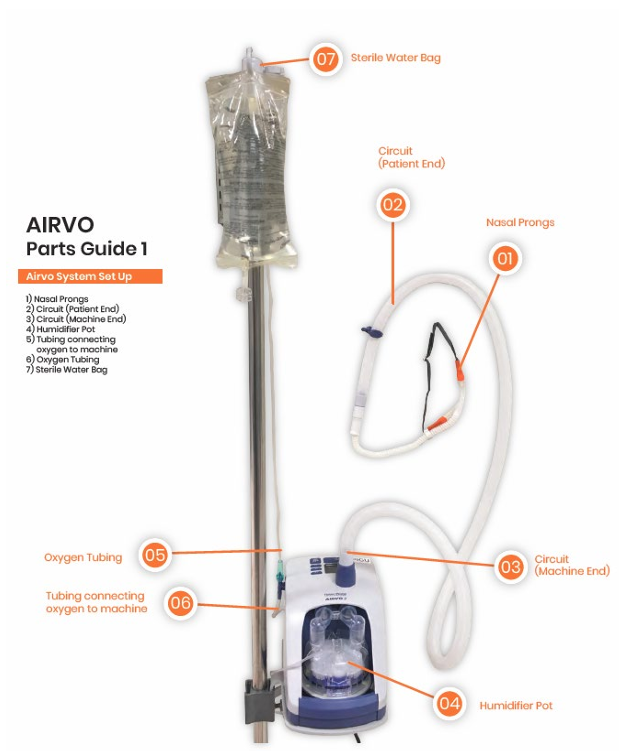
High Flow Nasal Cannula (HFNC) [Internet]. BC Children’s Hospital. 2024. Available from: https://shop.healthcarebc.ca/phsa/BCWH_2/BC%20Children%27s%20Hospital/C-05-12-60341.pdf
Set Up & Management
*Download guideline PDF for details
- PERFORM hand hygiene and DON personal protective equipment (PPE).
- VERIFY patient with two patient identifiers.
- REVIEW patient history, including baseline oxygen saturations. ASSESS patient for signs and symptoms of inadequate oxygenation and ventilation with current low flow oxygen therapy support. IDENTIFY need for high flow oxygen therapy.
- OBTAIN medical order indicating need for high flow oxygen therapy.
- SELECT appropriate high flow set up from either:
- Optiflow set up with 950 humidifier, or
- Airvo™ 2 set up
If device not circuited, see step 6.
6. CONNECT device circuitry.
For Optiflow with 950: PLACE humidifier chamber on humidification device. REMOVE chamber port caps. CONNECT circuit's inspiratory limb to the humidifier chamber. CONNECT pressure manifold for Optiflow Junior, or dual inlet adapter for Optiflow (adult) circuit, to remaining open port on humidifier chamber.
For Airvo™ 2: CONNECT Airvo™ 2 water chamber kit to the Airvo™ 2 unit. ENSURE the water feed tubing is positioned furthest from the Airvo™ 2 unit ports. CONNECT the Airvo™ 2 heated breathing tube to the Airvo™ 2 unit.
7. CONNECT 1000 mL sterile water for inhalation bag to humidifier chamber. SPIKE the water bag. ENSURE the bag is above the chamber.
8. ATTACH oxygen tubing, flowmeter, and high pressure hosing (if applicable).
For Optiflow with 950: ATTACH oxygen tubing from the pressure manifold or dual inlet adapter on humidifier pot to the flowmeter on the blender. If using FiO2 .21 (room air), ENSURE the oxygen analyzer is in line and turned on. ATTACH high pressure hoses to the oxygen and air 50psi outlets on the wall or boom.
For Airvo™ 2: If patient requires oxygen, POWER ON the Airvo™ 2 unit prior to adding oxygen. ATTACH oxygen tubing to port located on the side of the device to an oxygen flowmeter (attached to a 50psi outlet).
9. CONNECT appropriate size high flow nasal cannula/interface to proximal end of the inspiratory limb.
10. For Optiflow with 950 only: TURN ON humidifier to "Invasive" mode.
11. TURN ON flow as per orders and ADJUST desired oxygen concentration (O2%) on blender. or oxygen flow from flowmeter. ENSURE there is flow from patient interface before placing on patient.
Note that the FiO2 is achieved by
- Setting the O2% on the blender knob (Fisher & Paykel (F&P) Optiflow stand set-up)
- Adjusting the flow (Lpm) on the O2 flowmeter (Fisher & Paykel (F&P) Airvo™ 2 set up)
12. APPLY cannula to patient using wiggle pads.
13. MONITOR and COMPLETE site-to-source checks after initiation of high flow therapy. MONITOR the patient and perform a respiratory assessment Q3H and PRN.
High Flow Nasal Cannula (HFNC) [Internet]. BC Children’s Hospital. 2024. Available from: https://shop.healthcarebc.ca/phsa/BCWH_2/BC%20Children%27s%20Hospital/C-05-12-60341.pdf
Nasal Cannula Size & Prong Specific Flow Rate
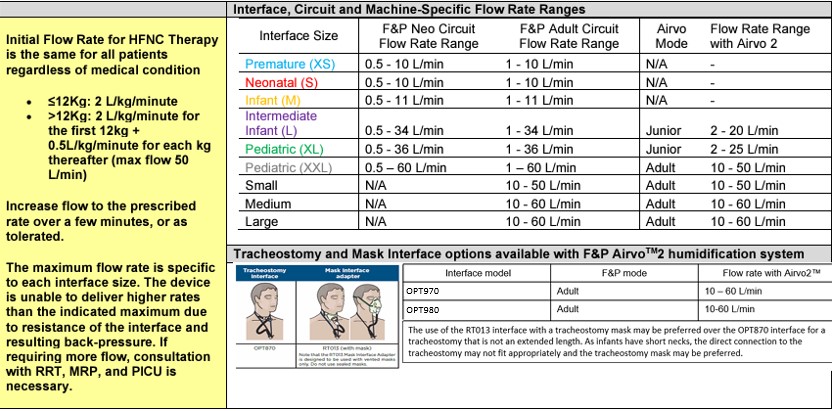
High Flow Nasal Cannula (HFNC) [Internet]. BC Children’s Hospital. 2024. Available from: https://shop.healthcarebc.ca/phsa/BCWH_2/BC%20Children%27s%20Hospital/C-05-12-60341.pdf
Troubleshooting
If your patient's condition is worsening or your patient is desaturating, start a site to source check as the first step for your troubleshooting.
Troubleshooting the Optiflow set up:
- If there is a disconnect anywhere in the circuit, NO alarm will sound. This is why it is crucial to perform regular site to source checks.
- If you hear a rattling sound, it may be water accumulated in the circuit. If you see water sloshing in the tubing, hold the circuit tubing up and allow water to drain back into the humidifier chamber. ENSURE you drain water towards the pot, and NOT towards the patient.
- If you hear a beeping or tweeting alarm, it is either coming from the humidifier or the oxygen analyzer.
- If it's the O2 analyzer alarm, check to see if the oxygen analyzer probe fell out from the circuit. If it's in place and still alarming, call the Respiratory Therapist (RT) or Virtual Support Line for support.
- If it's the humidifier alarm, check the water bag to see if it's empty. If there is still water in the bag, call the Respiratory Therapist (RT) or Virtual Support Line for support.
If the patient requires more oxygen to maintain SpO2 goals after performing a site to source check, increase the FiO2 by turning the dial on the blender. Do not adjust flow on the flowmeter.
Image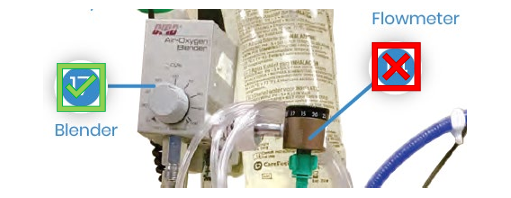
Troubleshooting the Airvo™ 2 set up:
- Alarms will display on the screen, as well as audible alert tones.
- If there is a disconnect anywhere in the circuit, "Check Tube" alarm will sound and be displayed on the display screen.
- Attempt to troubleshoot according to what alarm is displayed. Call the Respiratory Therapist (RT) or Virtual Support Line for assistance.
If the patient requires more oxygen to maintain SpO2 goals after performing a site to source check, increase the Fio2 by turning up the flow on the oxygen flowmeter.
Image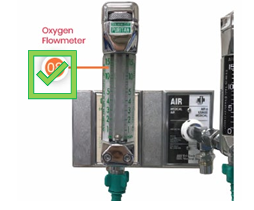
If the RN/RRT has completed all initial troubleshooting and there is still a problem, they should call the Virtual Support Line for support.
High Flow Nasal Cannula (HFNC) [Internet]. BC Children’s Hospital. 2024. Available from: https://shop.healthcarebc.ca/phsa/BCWH_2/BC%20Children%27s%20Hospital/C-05-12-60341.pdf
Medication Administration
- When at all possible, inhaled medication should be provided by removing prongs, then administering via MDI and spacer
- Both prongs must be removed from the nares regardless of delivery route. Never administer inhaled medication via nebulizer or MDI + spacer over the prongs, as the medication will not be delivered to the lungs.
High Flow Nasal Cannula (HFNC) [Internet]. BC Children’s Hospital. 2024. Available from: https://shop.healthcarebc.ca/phsa/BCWH_2/BC%20Children%27s%20Hospital/C-05-12-60341.pdf